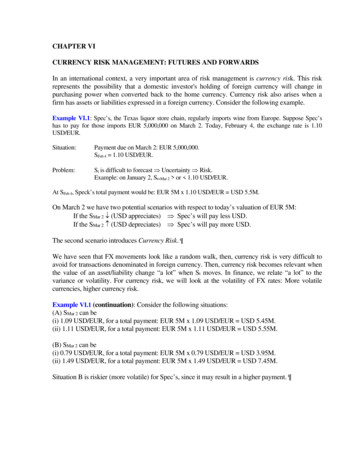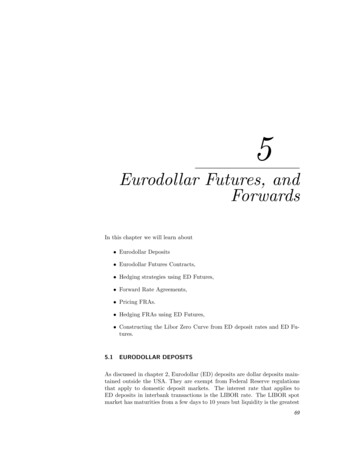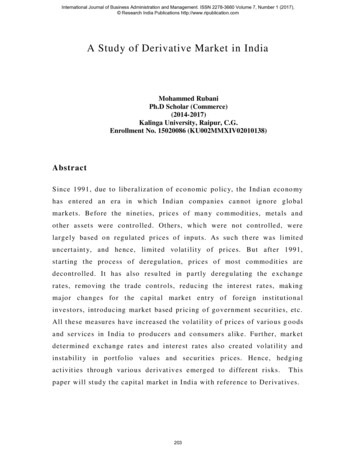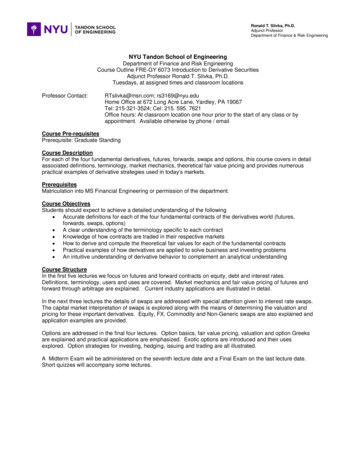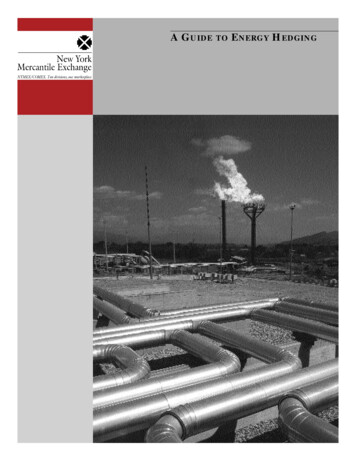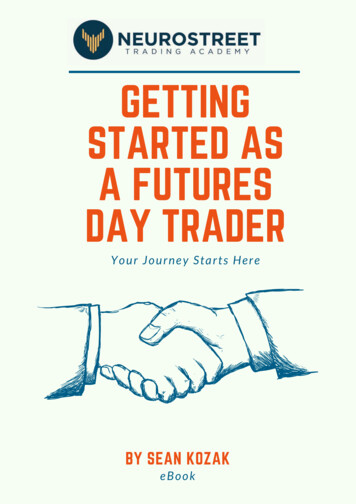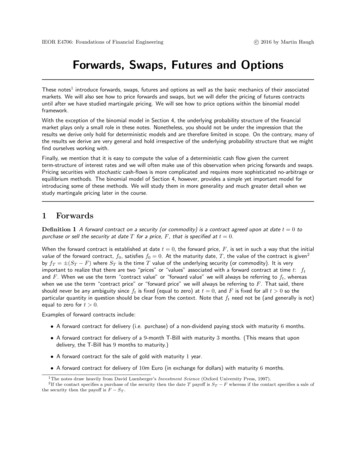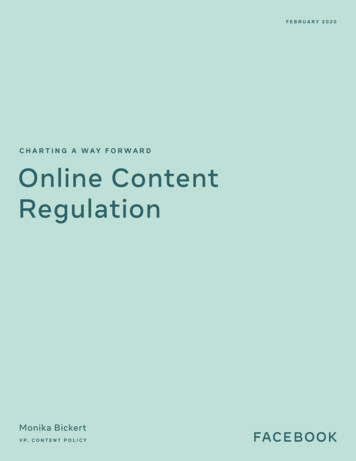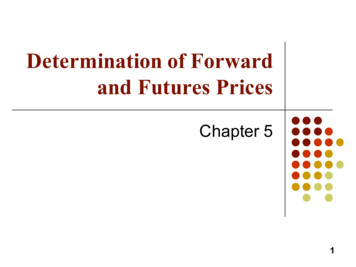
Transcription
Determination of Forwardand Futures PricesChapter 51
Consumption vs Investment AssetslInvestment assets are assets held by a significantnumber of people purely for investment purposes(Examples: stocks, bonds, gold, silver – although a fewpeople might also hold them for industrial purposes forexample).lConsumption assets are assets held primarily forconsumption (Examples: copper, oil, pork bellies) andnot usually for investment purposes.lArbitrage arguments will not work the same way forconsumption assets as they do for investment assets.2
Short Selling (Page 105-106)lShort selling or “shorting” involves sellingsecurities you do not own.lYour broker borrows the securities fromanother client and sells them in the marketin the usual way.3
Short Selling (continued)lAt some stage you must buy the securities sothey can be replaced in the account of theclient.lYou must pay dividends and other benefits theowner of the securities receives.lThere may be a small fee for borrowing thesecurities.4
ExamplelYou short 100 shares when the price is 100 and closeout the short position three months later when the price is 90.lDuring the three months a dividend of 3 per share ispaid.lWhat is your profit?lWhat would be your loss if you had bought 100 shares?5
ExamplelThe profit from shorting is 100 x [ 100 – 3 – 90 ] 700.lNote that the dividend payment lowered the price of thestock, and so the original owner of the stock, for whom thedividend was intended, must be compensated for it.lIf you had bought 100 shares instead, the loss would havebeen: 100 x [ –100 3 90 ] – 700.lThe profits/losses are mirror images of one another.6
Notation for Valuing Futures andForward ContractsS0: Spot price todayF0: Futures or forward price todayT: Time until delivery date (expressed in years)r: Risk-free interest rate for maturity T (alsoexpressed in years)7
An Arbitrage Opportunity?lSuppose that:llllThe spot price of a non-dividend-payingstock is 40.The 3-month forward/futures price is 43.The 3-month US interest rate is 5% perannum.Is there an arbitrage opportunity?8
An Arbitrage Opportunity? Yes.lSuppose that you borrow 40 for 3 months at the risk-free rateto buy the stock, and you use the money to buy the stock.lAt the same time, you enter into a short futures contract.lIn 3 months, you must deliver the stock (since you entered acontract to sell) and you collect 43 (the futures price).lYou repay the loan of 40x(1 0.05)(3/12) 40.49lYou get to keep: 43 - 40.49 2.51 with no risk/investment.9
Another Arbitrage Opportunity?lSuppose that:llllThe spot price of a non-dividend-paying stock is 40.The 3-month forward price is 39.The 3-month US interest rate is 5% perannum.Is there an arbitrage opportunity?10
Another Arbitrage Opportunity? Yes.lSuppose that you short the stock, receive 40, and invest the 40 for 3 months at the risk-free rate.lAt the same time, you enter into a long futures contract.lIn 3 months, you must buy the stock (since you entered acontract to buy) and you pay 39 (the futures price).lYou receive from your investment 40x(1 0.05)(3/12) 40.49lYou get to keep: 40.49 - 39 1.49 with no risk/investment.11
The Forward/Futures Price§What we conclude from the last two examples is that onecan make an arbitrage profit as the difference between thefutures prices F0 and 40x(1 0.05)(3/12) .§Therefore one can make an arbitrage profit by takingadvantage of the difference between F0 and S0(1 r)T.§To eliminate the presence of arbitrage, we must thereforehave:F0 S0(1 r)T12
The Forward/Futures PricelIf the spot price of an investment asset is S0 and thefutures price for a contract deliverable in T years isF0, then:F0 S0(1 r)Twhere r is the T-year risk-free rate of interest.lIn our examples, S0 40, T 0.25, and r 0.05 so thatthe no-arbitrage forward/futures price should be:F0 40(1.05)0.25 40.513
When using continuous compounding§F0 S0erT§This equation relates the forward price and the spot price for anyinvestment asset that provides no income and has no storage costs.§If short sales are not possible when the forward price is lower than the noarbitrage price, the no-arbitrage formula (continuous or regularcompounding) still works for an investment asset because investors whohold the asset (for investment purposes but not consumption) will sell it,invest the proceeds at the risk-free rate, and buy forward contracts.§If short sales are not possible when the forward price is higher than theno-arbitrage price, however, it’s a non-issue since the strategy would callfor buying the stock (instead of short-selling it).14
When an Investment Asset Providesa Known Dollar IncomelWhen an investment asset provides income with apresent value of I during the life of the forwardcontract, we can generalize the previous formulaas:F0 (S0 – I )erTwhere I is the present value of the income duringthe life of the forward contract.15
When an Investment Asset Providesa Known Dollar Income: ExamplelConsider a 10-month forward contract on a 50 stock, with acontinuous riskless rate of 8% per annum, and 0.75dividends expected after 3 months, 6 months, and 9 months.lThe present value of the dividends, I, is given by:I 0.75e-0.08x3/12 0.75e-0.08x6/12 0.75e-0.08x9/12 2.162lThe no-arbitrage forward price therefore must be:F0 (50-2.162) e0.08x10/12 51.1416
When an Investment Asset Providesa Known YieldlSometimes the underlying asset provides a known yieldrather than a known cash income.lThe yield can be viewed as the income as a percentage ofthe asset price at the time it is paid.lThe no-arbitrage formula then becomes:F0 S0 e(r–q )Twhere q is the average yield during the life of the contract(expressed with continuous compounding)17
When an Investment Asset Providesa Known Yield: ExamplelllllConsider a 6-month forward contract on a 25 assetexpected to produce a yield per annum of 3.96%, and a riskfree rate of 10%.The no-arbitrage price thus is: 25e(0.10-0.0396)x0.5 25.77Note that if you were not given the continuous yield directly but told thatthe income provided would be equal to 2% of the asset price during a 6month period, you would need to convert from discrete to continuous:2% in 6 months is equivalent to 3.96% per annum for 6 months withcontinuous compounding, because: 1 0.02 eq(1/2)Backing out q as 2ln(1 0.02) we get q 0.039618
Valuing a Forward ContractlA forward contract is worth zero (except for bid-offer spreadeffects) when it is first negotiated.lBanks are required to value all the contracts in their tradingbooks each day, as later the contract may have a positive ornegative value.lSuppose that K is the delivery price and F0 is the forward pricefor a contract that would be negotiated today.lThe delivery is in T years from today and the continuouslycompounded risk-free rate is r.19
Valuing a Forward ContractllBy considering the difference between a contract with delivery price K and acontract with delivery price F0 we can deduce that:lThe value, f, of a long forward contract isf (F0 K)e rT or f S0 Ke rTlThe value of a short forward contract isf (K – F0 )e–rT or f Ke rT – S0If the asset provides a known income with present value I or a known yield q,for a long forward contract position, we have:f (F0 K)e rT or f S0 I Ke rTorf (F0 K)e rT or f S0e qT Ke rT20
Valuing a Forward Contract: IntuitionlSuppose that, a while back, you entered into a long futurescontract to buy an asset for K.lToday, the same futures contracts has a price F0 thathappens to be higher than K.lThe older futures contract that you entered allows you toonly pay K instead of the higher F0 at expiration, a value orbenefit at expiration equal to F0 -K.lThus the present value today of that benefit is:f (F0 K)e rT21
Valuing a Forward Contract: IntuitionlSuppose that, a while back, you entered into a short futurescontract to sell an asset for K.lToday, the same futures contracts has a price F0 thathappens to be lower than K.lThe older futures contract that you entered allows you toreceive K instead of the lower F0 at expiration, a value orbenefit at expiration equal to K-F0.lThus the present value today of that benefit is:f (K F0)e rT22
Forward vs. Futures PriceslWhen the maturity and asset price are the same, forwardand futures prices are usually assumed to be equal.(Eurodollar futures are an exception, we will see this later).lWhen interest rates are uncertain, futures and forward pricesare, in theory, slightly different:lllA strong positive correlation between interest rates and the asset priceimplies the futures price is slightly higher than the forward price.A strong negative correlation implies the reverse.For most practical purposes, however, we will assume thatforward and futures prices are the same, equal to F0.23
Stock Index (Page 116)lCan be viewed as an investment assetpaying a dividend yield.lThe futures price and spot price relationshipis thereforeF0 S0 e(r–q )Twhere q is the dividend yield on the portfoliorepresented by the index during the life ofthe contract.24
Stock Index (continued)lFor the formula to be true, it is important that theindex represent an investable asset.lIn other words, changes in the index mustcorrespond to changes in the value of a tradableportfolio.lThe Nikkei index viewed as a dollar number doesnot represent an investment asset, since Nikkeifutures have a dollar value of 5 times the Nikkei.25
Stock Index: ExamplelConsider a 3-month futures contract on the S&P500 index where the index yields 1% per annum.lThe current index value is 1,300 and thecontinuously compounded riskless rate is 5%.lThe futures price F0 must be: 1,300e(0.05-0.01)x0.25lThus F0 1,313.0726
Index ArbitragelThe arbitrage strategies are the same as whendealing with an individual security.lWhen F0 S0e(r-q)T an arbitrageur buys the stocksunderlying the index and sells futures.lWhen F0 S0e(r-q)T an arbitrageur buys futuresand shorts or sells the stocks underlying theindex.27
Index Arbitrage (continued)lIndex arbitrage involves simultaneous trades in the indexfutures contract and in many different stocks.lVery often a computer is used to generate the trades: thisis an example of program trading, the trading of manystocks simultaneously with a computer.lOccasionally simultaneous trades are not possible and thetheoretical no-arbitrage relationship between F0 and S0does not hold, as on October 19, 1987 (“Black Monday”).28
Futures and Forwards onCurrencies (Page 117-121)lA foreign currency is analogous to a security providing ayield because the holder of the currency can earn interestat the risk-free interest rate prevailing in the foreigncountry.lThe yield is the foreign risk-free interest rate.lIt follows that if rf is the foreign risk-free interest rate,F0 S0e( r rf ) T29
Explanation of the RelationshipBetween Spot and Forward1000 units offoreign currency(time zero)r T1000e f units offoreign currencyat time Tr T1000 F0 e fdollars at time T1000S0 dollarsat time zero1000S0erTdollars at time T30
Arbitrage in Foreign ExchangeMarketslSuppose that the 2-year interest rates in Australia andthe United States are 5% and 7%.lThe spot exchange rate is 0.62 USD per AUD.lThe 2-year forward exchange rate or price should be:0.62e(0.07-0.05)x2 0.6453lWhat is the arbitrage if the forward rate is 0.63?What is the arbitrage if the forward rate is 0.66?l31
Arbitrage in Foreign ExchangeMarketslllllllIf the forward rate is 0.63, the forward is underpriced ( 0.6453).Take a long position in the forward contract: an agreement tobuy AUD in 2 years at the rate of 0.63Borrow 1,000 AUD today @ 5% per year, convert the amountimmediately to 1,000x0.62 620 USD and invest @ 7%.Two years later, 620 USD grow to 620e0.07x2 713.17 USD.Must repay the AUD loan: owe 1,000e0.05x2 1105.17 AUD.Use the forward to buy 1105.17 AUD, costing 1105.17x0.63 or696.26 USD and repay the loan balance of 1105.17 AUD.Keep the difference 713.17 – 696.26 16.91 USD.32
Arbitrage in Foreign ExchangeMarketslllllllIf the forward rate is 0.66, the forward is overpriced ( 0.6453).Take a short position in the forward contract: an agreement to sellAUD in 2 years at the rate of 0.66Invest in AUD today by first borrowing 1,000 USD @ 7% per year andconverting the amount immediately to 1,000/0.62 1,612.90 AUD.Therefore invest 1,612.90 AUD @ 5%.Two years later, 1,612.90 AUD grow to 1,612.90e0.05x2 1,782.53AUD.Must repay the USD loan: owe 1,000e0.07x2 1,150.27 USD.Use the forward to sell 1,782.53 AUD, giving you 1,782.53x0.66 or1,176.47 USD and repay the loan balance of 1,150.27 USD.Keep the difference 1,176.47 – 1,150.27 26.20 USD.33
Futures on Commodities that areInvestment Assets (Gold, Silver, )llllWith commodity futures, one has to take into accountpossible storage costs of the commodity (becauseimplementing an arbitrage strategy might imply the buying –and thus the storing – of the commodity).Storage costs can be viewed as negative income or yield.Letting u be the storage cost per unit time as a percent ofthe asset value, we have:F0 S0 e(r u )TAlternatively, letting U be the present value of the storagecosts, we have:F0 (S0 U )erT34
Futures on Commodities that areConsumption Assets (Copper, Oil, )llllWith commodities that are consumption assets, if the futures price isabove the no-arbitrage level, one sells the futures and buys theunderlying commodity, driving prices back in equilibrium.However, if the futures price is below the no-arbitrage level, thearbitrage strategy would entail buying the futures and selling theunderlying commodity. But if held for consumption purposes, it won’tbe sold. Thus the futures price will stay below its no-arbitrage level.Letting u be the storage cost per unit time as a percent of the assetvalue, we therefore have:F0 S0 e(r u )TAlternatively, letting U be the present value of the storage costs, wetherefore have:F0 (S0 U )erT35
Convenience YieldlWith consumption asset commodities we thus have:F0 S0 e(r u )TlTherefore the difference between F0 and S0 e(r u )T can beviewed as reflecting the convenience of holding the physicalconsumption asset (rather than the futures contract on it).lSo if we let y be the parameter that will equate the two:we then must have: F0 eyT S0 e(r u )Ty is referred to as the convenience yield, and we have:F0 S0 e(r u -y)Tll36
The Cost of Carry (Page 124)lThe cost of carry, c, is the interest cost - incomeearned storage costs, so c r – q ulFor an investment asset F0 S0ecTFor a consumption asset F0 S0ecTllThe convenience yield on the consumption asset,y, is defined so thatF0 S0 e(c–y )T37
Futures Prices & Expected FutureSpot PriceslSuppose k is the expected rate of return required byinvestors on an asset.lWe can invest F0e–r T at the risk-free rate and enter into along futures contract to create a cash inflow of ST atmaturity.lThis shows that:F0 e rT E ( ST )e kTorF0 E ( ST )e ( r k )T38
Futures Prices & Future Spot PricesNo Systematic Risk (β 0)k rF0 E(ST)Positive Systematic Risk (β 0)k rF0 E(ST)Negative Systematic Risk (β 0)k rF0 E(ST)Positive systematic risk: stock indices (Normal Backwardation)Negative systematic risk: gold (at least for some periods, Contango)However, the terms backwardation and contango are also often used todescribe whether the futures price is below or above the spot price S0.39
to buy the stock, and you use the money to buy the stock. l At the same time, you enter into a short futures contract. l In 3 months, you must deliver the stock (since you entered a contract to sell) and you collect 43 (the futures price). l You repay the loan of 40x(1 0.05)(3/12) 40.49 l You get to keep: 43 - 40.49 2.51 with no risk .
